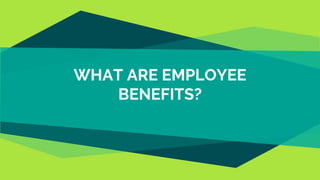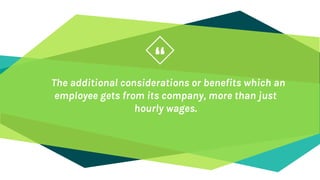Employee benefits
- 2. Hello! This presentation will be conducted by: Yash Vardhan Lohia, Pharmaceutics. Himanshu Zade, Quality Assurance. Ravin Sompura, Pharmaceutical Technology.
- 4. “ The additional considerations or benefits which an employee gets from its company, more than just hourly wages.
- 5. EMPLOYEE BENEFIT PROGRAMS • Part of a Total Compensation. • Provided by the Government. • Incentives. • Part of Cost of doing Business. • Indirect Compensation.
- 6. FACTORS OF GROWTH OF BENEFIT • Discouraging Unions. • Non taxable Benefits. • Easier to negotiate wages. • Attitude of general public.
- 8. OBJECTIVE OF BENEFIT PROGRAMS • Improve Morale. • Meet Health and Safety Needs. • Attract Good Employees. • Reduce Turnover. • Reduce Unionism. • Maintain a Competitive Position. • Enhance the Organization's Image.
- 10. BENEFITS REQUIRED BY LAW Legally required benefits/Mandatory benefits • Social Security. • Unemployment Compensation. • Worker’s Compensation. • Family and Worker Leave Act.
- 11. VOLUNTARY BENEFITS Health Insurance • Traditional Health Insurance. • Health Maintenance Organization. (HMO) • Preferred Provider Organization. (PPO) • Point-of-Service. (POS) • Consumer Driven Health Plan. (CDHP)
- 12. HEALTH PLANS BY EMPLOYERS Conventional 1% HMO 17% PPO 55% POS 10% HDHP/ CDHP 17%
- 13. RETIREMENT BENEFITS • Pension plans. i. Contributory (joint pay) ii. Non-Contributory (employer pays) • Pre-retirement counseling.
- 14. DEFINED BENEFIT PLAN • Amount is Specifically Defined. • Years of Service Required. • Average Earnings During Certain Years. • Age at Retirement.
- 15. DEFINED CONTRIBUTION PLAN • Basis Upon Which the Employer Pays. • Paid to Thrift Plan, IRA, etc. • Benefits Depends Upon Accumulation.
- 16. PAYMENT FOR TIME NOT WORKED • Holidays and Vacations. • Disability ( Short and Long Term) • Sick leave.
- 17. SURVIVOR BENEFITS • Group life Insurance. • Travel Insurance.
- 18. EMPLOYEE SERVICES AND FAMILY-FRIENDLY PLANS • Employee assistance program • Counseling services • Child care • Elder care • Food services • Health services • Legal services • Credit unions • Educational assistance plans • Financial planning • Housing and moving expenses • Transportation pooling/parking • Purchasing assistance • Social and recreational services • Awards
- 19. FLEXIBLE BENEFIT PLANS Benefit plan that enable individual employees to choose the benefits that are best suited to their particular needs. • Employees Choose. • Cafeteria Plans. • Cost Attached. • Some Government Requirements.
- 21. COST RELATED TO BENEFIT • Cost incurred is 30-40% of the Annual Wages. • The fastest growing part of the total compensation.
- 22. 71,839$Total amount of money spent on an Employee 31%Of the Employee’s Salary. 50,000$Annual salary of the Employee
- 23. So, if a company has 4000 employees, what does that amount become?
- 24. 372,00,000$That’s a big number, isn’t it?
- 25. TYPICAL COST OF BENEFITS TYPES OF BENEFITS TOTAL PERCENTAGE, ALL COMPANIES Payments for vacations, sick leave, holidays, etc. 12.0% Legally required payments 10.0 % Medical and medically related benefit payments 10.0 % Retirement and savings (employer’s share) 7.0 % Paid rest periods, lunch periods, etc. 3.0 % Miscellaneous benefits 1.0% Life insurance .5% Total employee benefits as percent of payroll 43.5%
- 26. HEALTH PLAN COSTS Average Annual Health Plan Costs Per Employee COST YEAR
- 27. INCREASE IN COST OF HEALTHCARE • Federal Regulation • Changes in Pricing • Advances in Medicine • Malpractice Insurance • Labor Costs • Over Utilization of Facilities • Elder Care • Transplants/AIDS/Other
- 29. ADVANTAGES • Helps retain the quality employees. • Exemption of taxes by providing insurance. • Employees stay happy with the current pay. • Offering amenities at a lower cost. • Insurance provisions allow employees to be more productive.
- 30. RESULT OF EMPLOYEE BENEFIT BALANCEWORK LIFE
- 31. DISADVANTAGES • Difficulties in keeping benefits equal for different job positions. • Any single mistake in benefits might lead to lawsuit or regulatory fine. • Offering amenities requires legal help, which in turn increases legal fees. • Benefits need a better and bigger administration to handle the employees.
- 32. Thanks! Any questions? Feel free to ask!































